- Accueil
- Pages cachées
- 15 JUIN 2023 NEWS
15 JUIN 2023 NEWS
INSTITUT SUPERIEUR D'ANTHROPOLOGIE
INSTITUTE OF ANTHROPOLOGY
ONLINE COURSES / COURS A DISTANCE
DEBUT COURS : SEPTEMBRE 2023
REGISTER NOW
PEROU – 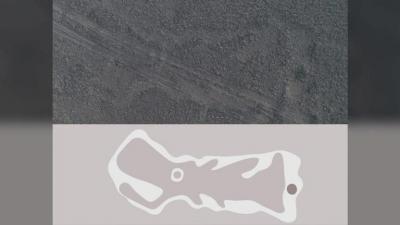
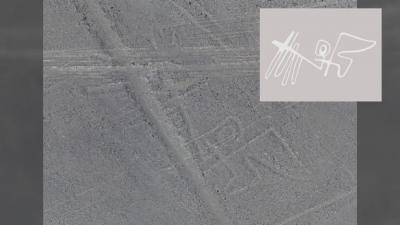
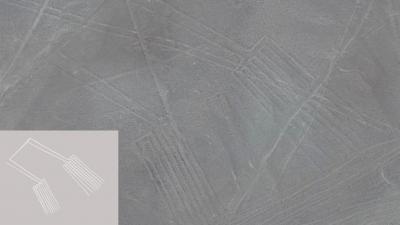
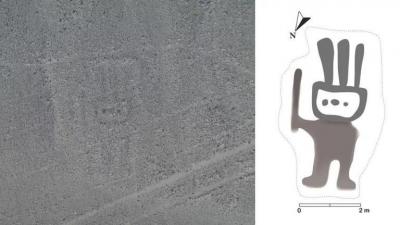 Nazca - Perdues dans le désert de Nazca au Pérou, trois nouvelles figures gigantesques ont été découvertes grâce à l'intelligence artificielle. Dessinées il y a environ 2 400 ans, ces "Lignes de Nazca" sont d'une étonnante diversité et d'une ampleur surprenante. La plus grande des nouvelles figures est une paire de jambes s'étendant sur plus de 77 mètres. Les scientifiques ont aussi trouvé un poisson de 19 mètres et un oiseau de 17 mètres. Ces figures, appelées géoglyphes, sont incisées à la surface du désert de Nazca. Les pierres noires sont déplacées pour révéler le sable blanc dessous, créant ces impressionnant dessins. Ces nouvelles découvertes portent à plus de 350 le nombre de géoglyphes mis à jour depuis leur première observation dans les années 1920. Parmi eux, on trouve des figures représentant des colibris, des singes, des baleines, des araignées, des fleurs et des outils. Même si la majorité de ces figures se trouvent dans le désert de Nazca, d'autres ont aussi été découvertes ailleurs au Pérou. L'équipe de recherche, menée par le professeur Masato Sakai de l'Université de Yamagata au Japon, a analysé pendant cinq ans des photographies aériennes haute résolution de toute la région. Grâce à un système d'intelligence artificielle développé en collaboration avec IBM, l'équipe a pu identifier plusieurs nouveaux géoglyphes. Ce système d'intelligence artificielle a réussi à identifier des figures potentielles 21 fois plus rapidement qu'un archéologue formé. Cela a permis aux scientifiques de se rendre sur les sites les plus prometteurs pour vérifier leur existence.
Nazca - Perdues dans le désert de Nazca au Pérou, trois nouvelles figures gigantesques ont été découvertes grâce à l'intelligence artificielle. Dessinées il y a environ 2 400 ans, ces "Lignes de Nazca" sont d'une étonnante diversité et d'une ampleur surprenante. La plus grande des nouvelles figures est une paire de jambes s'étendant sur plus de 77 mètres. Les scientifiques ont aussi trouvé un poisson de 19 mètres et un oiseau de 17 mètres. Ces figures, appelées géoglyphes, sont incisées à la surface du désert de Nazca. Les pierres noires sont déplacées pour révéler le sable blanc dessous, créant ces impressionnant dessins. Ces nouvelles découvertes portent à plus de 350 le nombre de géoglyphes mis à jour depuis leur première observation dans les années 1920. Parmi eux, on trouve des figures représentant des colibris, des singes, des baleines, des araignées, des fleurs et des outils. Même si la majorité de ces figures se trouvent dans le désert de Nazca, d'autres ont aussi été découvertes ailleurs au Pérou. L'équipe de recherche, menée par le professeur Masato Sakai de l'Université de Yamagata au Japon, a analysé pendant cinq ans des photographies aériennes haute résolution de toute la région. Grâce à un système d'intelligence artificielle développé en collaboration avec IBM, l'équipe a pu identifier plusieurs nouveaux géoglyphes. Ce système d'intelligence artificielle a réussi à identifier des figures potentielles 21 fois plus rapidement qu'un archéologue formé. Cela a permis aux scientifiques de se rendre sur les sites les plus prometteurs pour vérifier leur existence.
Une Intelligence Artificielle découvre trois nouveaux Géoglyphes de Nazca (msn.com)
ANGLETERRE - Eynsham - The discovery was made during excavations on the site of the A40 Science Transit park & ride at Eynsham for Balfour Beatty, acting on behalf of Oxfordshire County Council. The team were excavating an Early Bronze Age cremation burial when they uncovered the grave of a child and a piece of worked animal bone in a shallow pit. A closer examination by Sharon Clough (CA Osteoarchaeologist) and Matty Holmes (Consultant Zooarchaeologist) has revealed that the bone is actually a pin fashioned from the phalanx (toe bone) of a golden eagle, the only example found in a funerary context from the Bronze Age in England. A hole in one end of the pin suggests that it was worn with a fibre cord and was likely deposited in the burial as a pyre good. According to the researchers: “The choice of eagle bone is likely to have been significant and it is possible such an object could have been considered talismanic, or was linked perhaps with afterlife beliefs, raising further questions about its use as a pyre good for a child.” Excavations also revealed evidence for roundhouse buildings, post-built structures, and probable livestock enclosures dating from the Middle Iron Age. The roundhouses are defined by shallow ring ditches that represent drainage features enclosing a central building, and several pits and postholes were discovered within the interiors of two of these roundhouses, which would have held structural elements, such as posts for roof supports.
Eynsham - The discovery was made during excavations on the site of the A40 Science Transit park & ride at Eynsham for Balfour Beatty, acting on behalf of Oxfordshire County Council. The team were excavating an Early Bronze Age cremation burial when they uncovered the grave of a child and a piece of worked animal bone in a shallow pit. A closer examination by Sharon Clough (CA Osteoarchaeologist) and Matty Holmes (Consultant Zooarchaeologist) has revealed that the bone is actually a pin fashioned from the phalanx (toe bone) of a golden eagle, the only example found in a funerary context from the Bronze Age in England. A hole in one end of the pin suggests that it was worn with a fibre cord and was likely deposited in the burial as a pyre good. According to the researchers: “The choice of eagle bone is likely to have been significant and it is possible such an object could have been considered talismanic, or was linked perhaps with afterlife beliefs, raising further questions about its use as a pyre good for a child.” Excavations also revealed evidence for roundhouse buildings, post-built structures, and probable livestock enclosures dating from the Middle Iron Age. The roundhouses are defined by shallow ring ditches that represent drainage features enclosing a central building, and several pits and postholes were discovered within the interiors of two of these roundhouses, which would have held structural elements, such as posts for roof supports.
https://www.heritagedaily.com/2023/06/golden-eagle-pin-found-in-bronze-age-burial/147616
SUEDE – 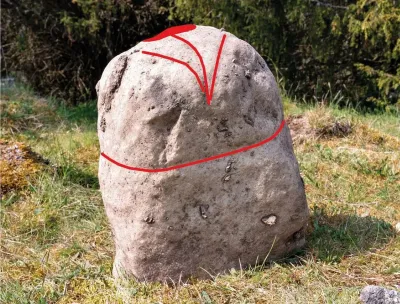 Tystberga - The discovery was made during preliminary excavations for the construction of the Ostlänken Railway Project in Tystberga, Södermanland County, Sweden. According to Rebecka Jonsson, an archaeologist from Uppdrag Arkeologi, many similar examples have been discovered in Norway, however, phallus symbols from the Viking Age are very unusual in Sweden. A phallus is generally defined as an object that resembles a penis (especially when erect), often representing fertility and cultural implications that are associated with the male sexual organ as well as the male orgasm. In Norse mythology, the god Freyr, was a phallic deity worshiped in Sweden and was associated with peace and pleasure, and was represented with a phallic statue in the Temple at Uppsala. Some researchers also consider the phallus to be a symbol of the god Heimdall, who in Norse mythology is one of the gods who will lead in the new world after the apocalyptic Ragnarøk event. According to the researchers: “The stone was found superficially and centrally in the stone packing for a grave pile, and only a few meters next to it is an egg-shaped tombstone. Often they are interpreted with notions of fertility.” The phallic stone measures half a metre in height and was carved from a local quarry. The underside has been carved with a flat base and leans at an angle of 60 degrees, while the top has carved lines to resemble a phallus.
Tystberga - The discovery was made during preliminary excavations for the construction of the Ostlänken Railway Project in Tystberga, Södermanland County, Sweden. According to Rebecka Jonsson, an archaeologist from Uppdrag Arkeologi, many similar examples have been discovered in Norway, however, phallus symbols from the Viking Age are very unusual in Sweden. A phallus is generally defined as an object that resembles a penis (especially when erect), often representing fertility and cultural implications that are associated with the male sexual organ as well as the male orgasm. In Norse mythology, the god Freyr, was a phallic deity worshiped in Sweden and was associated with peace and pleasure, and was represented with a phallic statue in the Temple at Uppsala. Some researchers also consider the phallus to be a symbol of the god Heimdall, who in Norse mythology is one of the gods who will lead in the new world after the apocalyptic Ragnarøk event. According to the researchers: “The stone was found superficially and centrally in the stone packing for a grave pile, and only a few meters next to it is an egg-shaped tombstone. Often they are interpreted with notions of fertility.” The phallic stone measures half a metre in height and was carved from a local quarry. The underside has been carved with a flat base and leans at an angle of 60 degrees, while the top has carved lines to resemble a phallus.
https://www.heritagedaily.com/2023/06/viking-age-phallic-stone-found-in-sweden/147609
PEROU –  Muralla La Cumbre - The Chimú culture emerged around AD 850-900 and controlled a territory encompassing 1,000 km (620 mi) of coastline from Piura in the north to Paramonga in the south. The Kingdom was centred on Chan Chan, a large adobe city located at the mouth of the Moche Valley in an arid area of coastal desert. The city reached its peak during the 15th century AD, where it is estimated to have had a population of around 40,000 to 60,000 inhabitants. The Chimú constructed the Muralla La Cumbre, a large trapezoidal stone wall during the 13th or 14th century AD, which runs from Cerro Cabras to Cerro Campana over a distance of 10 km. Various theories for the purpose of the wall have been proposed, with the most prominent being as a territorial delimitation of the Chimú capital, to protect the city from Inca invasion, or as a ceremonial causeway. Excavations led by archaeologist, Gabriel Prieto Burméster, Director of the Huanchaco (Pahuan) Archaeological Project, has suggested that the wall was instead built to protect Chan Chan from El Niño events. El Niño events may have led to the demise of the Moche and other pre-Columbian Peruvian cultures. A recent study, titled “Global impact of the 1789-93 El Niño”, even suggests that a strong El Niño event caused poor crop yields in Europe, which in turn helped spark the French Revolution. The researchers found an accumulation of almost two metres of sediment with multiple interstices of sand and mud which only occur on one side of the wall. There are 12 interstices detected, suggesting 12 climatic events. A radio carbon analysis of roots found in one of the sediment layers has revealed a date of AD 1400-1450. This period coincides with a large sacrifice of 250 children and 40 warriors discovered near Chan Chan in 2019, which experts at the time suggest was to appease the gods for protection against natural catastrophes linked to El Niño events.
Muralla La Cumbre - The Chimú culture emerged around AD 850-900 and controlled a territory encompassing 1,000 km (620 mi) of coastline from Piura in the north to Paramonga in the south. The Kingdom was centred on Chan Chan, a large adobe city located at the mouth of the Moche Valley in an arid area of coastal desert. The city reached its peak during the 15th century AD, where it is estimated to have had a population of around 40,000 to 60,000 inhabitants. The Chimú constructed the Muralla La Cumbre, a large trapezoidal stone wall during the 13th or 14th century AD, which runs from Cerro Cabras to Cerro Campana over a distance of 10 km. Various theories for the purpose of the wall have been proposed, with the most prominent being as a territorial delimitation of the Chimú capital, to protect the city from Inca invasion, or as a ceremonial causeway. Excavations led by archaeologist, Gabriel Prieto Burméster, Director of the Huanchaco (Pahuan) Archaeological Project, has suggested that the wall was instead built to protect Chan Chan from El Niño events. El Niño events may have led to the demise of the Moche and other pre-Columbian Peruvian cultures. A recent study, titled “Global impact of the 1789-93 El Niño”, even suggests that a strong El Niño event caused poor crop yields in Europe, which in turn helped spark the French Revolution. The researchers found an accumulation of almost two metres of sediment with multiple interstices of sand and mud which only occur on one side of the wall. There are 12 interstices detected, suggesting 12 climatic events. A radio carbon analysis of roots found in one of the sediment layers has revealed a date of AD 1400-1450. This period coincides with a large sacrifice of 250 children and 40 warriors discovered near Chan Chan in 2019, which experts at the time suggest was to appease the gods for protection against natural catastrophes linked to El Niño events.
ISRAEL –  Hyrcania - A desert hilltop in the Judean Desert called "Hyrcania " is one of the most interesting historical sites in the Holy Land, but, it has never been excavated, until today. Archaeologists and volunteers gathered last month for the first time to dig and research the magnificent site, whose history goes back to the second century BCE. Hyrcania is mentioned in Josephus' book "Antiquities of the Jews" as one of the three fortresses that queen Salome Alexandra, wife of Alexander Janneaus (the second Hasmonean king who ruled the land during the first century BCE), refused to give up to the Pharisee party. Later, the site was associated with the famous king Herod the Great. It was known as the place where the Roman-appointed king of Judea imprisoned and tortured his rivals. The fortress is also linked to the copper scroll, one of the famous Dead Sea scrolls, which contains instructions about a mysterious treasure. Dr. Oren Gutfeld, the head of the excavation, has a long history of research in the area. He excavated the tunnels located on the slop of the hill, tunnel which he believed are associated with the copper scroll. "We assume that the treasures which are mentioned in the scroll are the treasures of the temple. The late archaeologist Hanan Eshel suggested that they are also treasures from the first temple era" Gutfeld said, "we conducted excavations in two locations, of two tunnels on the foothill. They were huge - two-meter high, one meter wide, with a length of 123 meters." Unfortunately, no treasures were found in the tunnels.
Hyrcania - A desert hilltop in the Judean Desert called "Hyrcania " is one of the most interesting historical sites in the Holy Land, but, it has never been excavated, until today. Archaeologists and volunteers gathered last month for the first time to dig and research the magnificent site, whose history goes back to the second century BCE. Hyrcania is mentioned in Josephus' book "Antiquities of the Jews" as one of the three fortresses that queen Salome Alexandra, wife of Alexander Janneaus (the second Hasmonean king who ruled the land during the first century BCE), refused to give up to the Pharisee party. Later, the site was associated with the famous king Herod the Great. It was known as the place where the Roman-appointed king of Judea imprisoned and tortured his rivals. The fortress is also linked to the copper scroll, one of the famous Dead Sea scrolls, which contains instructions about a mysterious treasure. Dr. Oren Gutfeld, the head of the excavation, has a long history of research in the area. He excavated the tunnels located on the slop of the hill, tunnel which he believed are associated with the copper scroll. "We assume that the treasures which are mentioned in the scroll are the treasures of the temple. The late archaeologist Hanan Eshel suggested that they are also treasures from the first temple era" Gutfeld said, "we conducted excavations in two locations, of two tunnels on the foothill. They were huge - two-meter high, one meter wide, with a length of 123 meters." Unfortunately, no treasures were found in the tunnels.
ANGLETERRE – 

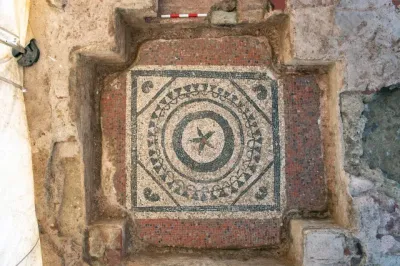 Southwark - The most “intact” Roman mausoleum in Britain has been discovered in south London by archaeologists. The “completely unique” find was uncovered at a new development site - The Liberty of Southwark - near Borough Market and London Bridge Station.The remains of the mausoleum - a type of monumental tomb - has a mosaic surrounded by a raised platform on which the burials were placed. The remains also include the walls, interior flooring and the lowest entrance steps, making it the most intact Roman mausoleum ever to be discovered in Britain. The mausoleum underwent significant modifications during its lifetime and archaeologists uncovered a second mosaic directly beneath the first, MOLA said. The two mosaics are similar in design, with a central flower surrounded by a pattern of concentric circles set within a pavement formed of small red tiles. he mausoleum would have been used by wealthier members of Roman society, it is understood. It may have been a family tomb or perhaps belonged to a burial club, where members would have paid a monthly fee to be buried inside. Archaeologists didn’t find any of the coffins or burials that would have originally been inside the mausoleum. However, over 100 coins were discovered, together with some scrap pieces of metal, fragments of pottery and roofing tiles. The area immediately surrounding the mausoleum contained over 80 Roman burials, which included personal items such as copper bracelets, glass beads, coins, pottery, and even a bone comb.
Southwark - The most “intact” Roman mausoleum in Britain has been discovered in south London by archaeologists. The “completely unique” find was uncovered at a new development site - The Liberty of Southwark - near Borough Market and London Bridge Station.The remains of the mausoleum - a type of monumental tomb - has a mosaic surrounded by a raised platform on which the burials were placed. The remains also include the walls, interior flooring and the lowest entrance steps, making it the most intact Roman mausoleum ever to be discovered in Britain. The mausoleum underwent significant modifications during its lifetime and archaeologists uncovered a second mosaic directly beneath the first, MOLA said. The two mosaics are similar in design, with a central flower surrounded by a pattern of concentric circles set within a pavement formed of small red tiles. he mausoleum would have been used by wealthier members of Roman society, it is understood. It may have been a family tomb or perhaps belonged to a burial club, where members would have paid a monthly fee to be buried inside. Archaeologists didn’t find any of the coffins or burials that would have originally been inside the mausoleum. However, over 100 coins were discovered, together with some scrap pieces of metal, fragments of pottery and roofing tiles. The area immediately surrounding the mausoleum contained over 80 Roman burials, which included personal items such as copper bracelets, glass beads, coins, pottery, and even a bone comb.
https://uk.sports.yahoo.com/news/rare-roman-mausoleum-unearthed-southwark-164850684.html
PEROU –  Huaca La Florida - A mummy of what is thought to be a man who lived more than 3,000 years ago was found wrapped in a funeral bundle at Huaca La Florida, situated in the district of Rimac in the Peruvian capital Lima. Initially, researchers found evidence of pieces of hair. Afterwards, they found the skull and a stone tomb, wrapped in a funerary bundle made of native cotton attached to reeds intertwined with each other, with remains such as bottlenecks, necklace beads, corn, shells, shellfish, coca leaves, and seeds. This evidences that they were placed there as post-death offerings. The finds are believed to date from 1100 B.C. to 1400 B.C.
Huaca La Florida - A mummy of what is thought to be a man who lived more than 3,000 years ago was found wrapped in a funeral bundle at Huaca La Florida, situated in the district of Rimac in the Peruvian capital Lima. Initially, researchers found evidence of pieces of hair. Afterwards, they found the skull and a stone tomb, wrapped in a funerary bundle made of native cotton attached to reeds intertwined with each other, with remains such as bottlenecks, necklace beads, corn, shells, shellfish, coca leaves, and seeds. This evidences that they were placed there as post-death offerings. The finds are believed to date from 1100 B.C. to 1400 B.C.
https://andina.pe/Ingles/noticia-over-3000yearold-mummy-uncovered-in-peru-943689.aspx
ISRAEL –  Palmachim - An Israeli woman found a more than 3,000-year-old statuette of an Egyptian goddess Hathor, while walking on Palmachim beach, south of Tel Aviv. srael Antiquities Authority confirmed it was a figurine of the Egyptian goddess Hathor used for worship in the Canaanite culture during the Bronze Age. “The Canaanites used to adopt rituals and religious customs from the Egyptians, who ruled our region at that time. Just like homes today, where you install a mezuzah or hang a picture of a saint on the wall, back then they used to place ritual figurines in a central place in the house, for good luck and protection from bad things,” explained Golani. “We can recognize that this is Hathor by her hairstyle, which simulates the horns of a bull, and by the prominent eyes and ears that were designed for her. Hathor was a powerful goddess who symbolized many virtues for the Egyptians - fertility, strength, protection, and wisdom," he added.
Palmachim - An Israeli woman found a more than 3,000-year-old statuette of an Egyptian goddess Hathor, while walking on Palmachim beach, south of Tel Aviv. srael Antiquities Authority confirmed it was a figurine of the Egyptian goddess Hathor used for worship in the Canaanite culture during the Bronze Age. “The Canaanites used to adopt rituals and religious customs from the Egyptians, who ruled our region at that time. Just like homes today, where you install a mezuzah or hang a picture of a saint on the wall, back then they used to place ritual figurines in a central place in the house, for good luck and protection from bad things,” explained Golani. “We can recognize that this is Hathor by her hairstyle, which simulates the horns of a bull, and by the prominent eyes and ears that were designed for her. Hathor was a powerful goddess who symbolized many virtues for the Egyptians - fertility, strength, protection, and wisdom," he added.
NORVEGE – 

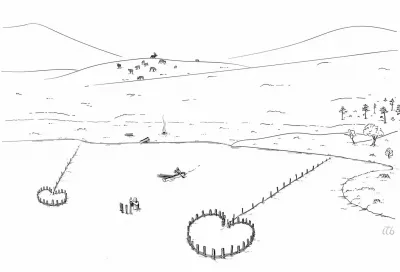 Tesse - In the seabed of the mountain lake Tesse in Jotunheimen, 850 metres above sea level, archaeologists from the Museum of Cultural History in Oslo (KHM) are digging as fast as they can. Towards the end of this week, all traces of the 7,000-year-old fish traps will be covered by water again. The four fish traps discovered by mountain hiker Reidar Marstein last summer consist of long poles that have been driven into the seabed. They form the pattern of a fence that has guided the fish into a chamber. From there, Stone Age folks could easily use a fishing net to catch the fish they needed. Each chamber consisted of around 40-50 poles, and the archaeologists have found remains that are as much as 80 centimetres long. In the Norwegian mountains, archaeologists mostly find stone objects and animal bones from the Stone Age. Processed wood from this time period has hardly been found before. “Here we can also see how the wood has been designed,” Mjærum says. “Actual traces of axe chopping from the Stone Age is something we almost never find in Norway otherwise.” Perhaps the archaeologists will be able to find out what kind of tools were used to process the poles. In fact, perhaps they already found them, during previous excavations up here.
Tesse - In the seabed of the mountain lake Tesse in Jotunheimen, 850 metres above sea level, archaeologists from the Museum of Cultural History in Oslo (KHM) are digging as fast as they can. Towards the end of this week, all traces of the 7,000-year-old fish traps will be covered by water again. The four fish traps discovered by mountain hiker Reidar Marstein last summer consist of long poles that have been driven into the seabed. They form the pattern of a fence that has guided the fish into a chamber. From there, Stone Age folks could easily use a fishing net to catch the fish they needed. Each chamber consisted of around 40-50 poles, and the archaeologists have found remains that are as much as 80 centimetres long. In the Norwegian mountains, archaeologists mostly find stone objects and animal bones from the Stone Age. Processed wood from this time period has hardly been found before. “Here we can also see how the wood has been designed,” Mjærum says. “Actual traces of axe chopping from the Stone Age is something we almost never find in Norway otherwise.” Perhaps the archaeologists will be able to find out what kind of tools were used to process the poles. In fact, perhaps they already found them, during previous excavations up here.
ANGLETERRE –  Calstock - Newcastle University archaeologist Dr Chloe Duckworth, go to Calstock Roman fort, near the river Tamar in Cornwall, to find out why it was built at that particular location, if there was a vicus – a civilian area immediately outside the fort - and how it related to the rest of Roman Cornwall. Dating from around AD 50, Calstock Roman fort was discovered in 2007 by a team led by Dr Chris Smart from the University of Exeter while carrying out geophysical surveys of the area to look for signs of a Medieval silver mining industry. Dr Smart has led a programme of funded research digs at Calstock since 2008, which has mapped out the scale of the fort and many of the buildings within it. Until recently, it was thought that the Roman frontier in South West Britain stopped at Exeter but the discovery of Calstock Roman fort led to new questions about why the Romans came to Cornwall and what they were doing there.Cornwall has been internationally important for metal production, especially tin, since the Bronze Age but, to date, no evidence for mining in Cornwall by the Romans has been found, despite it being knoTn for some time that they were interested in Britain for its mineral resources.they try to learn more about some of the features that showed up on the 2007 geophysical survey of the site including a road that appears to lead into the fort and could have connected it to the rest of Cornwall, and some mysterious black patches. During the programme, Dr Duckworth analyses pieces of rocky material found while excavating these strange patches using a specialist portable x-ray fluorescence (pXRF) device. This shows that it was Roman mining waste and is the first excavated evidence that the Romans were mining for the mineral-rich deposits in Cornwall.
Calstock - Newcastle University archaeologist Dr Chloe Duckworth, go to Calstock Roman fort, near the river Tamar in Cornwall, to find out why it was built at that particular location, if there was a vicus – a civilian area immediately outside the fort - and how it related to the rest of Roman Cornwall. Dating from around AD 50, Calstock Roman fort was discovered in 2007 by a team led by Dr Chris Smart from the University of Exeter while carrying out geophysical surveys of the area to look for signs of a Medieval silver mining industry. Dr Smart has led a programme of funded research digs at Calstock since 2008, which has mapped out the scale of the fort and many of the buildings within it. Until recently, it was thought that the Roman frontier in South West Britain stopped at Exeter but the discovery of Calstock Roman fort led to new questions about why the Romans came to Cornwall and what they were doing there.Cornwall has been internationally important for metal production, especially tin, since the Bronze Age but, to date, no evidence for mining in Cornwall by the Romans has been found, despite it being knoTn for some time that they were interested in Britain for its mineral resources.they try to learn more about some of the features that showed up on the 2007 geophysical survey of the site including a road that appears to lead into the fort and could have connected it to the rest of Cornwall, and some mysterious black patches. During the programme, Dr Duckworth analyses pieces of rocky material found while excavating these strange patches using a specialist portable x-ray fluorescence (pXRF) device. This shows that it was Roman mining waste and is the first excavated evidence that the Romans were mining for the mineral-rich deposits in Cornwall.
https://www.ncl.ac.uk/press/articles/latest/2023/06/greatbritishdig/
FRANCE –  Marsac-sur-l’Isle - Depuis fin avril, les équipes du Service de l’Archéologie du Conseil Départemental de la Dordogne, menées par Céline Lagarde-Cardona, protohistorienne et spécialiste des métaux, scrutent le sol d’un site de près de 11.000m², situé sur la zone d’activités de Péri-Ouest, à Marsac-sur-l’Isle. Lors de ces fouilles, on a tout d’abord agi avec doigté : à la pelle mécanique. En affinant au final, plus de 500 fosses ont été mises à jour, témoignant du passage de l’homme dans la zone. Deux grandes périodes de fréquentation du site ont été identifiées : au Paléolithique (il y a environ 35.000 ans) et vers le 2e siècle avant notre ère. Les fouilles doivent se poursuivre jusqu’au 1er août 2023.
Marsac-sur-l’Isle - Depuis fin avril, les équipes du Service de l’Archéologie du Conseil Départemental de la Dordogne, menées par Céline Lagarde-Cardona, protohistorienne et spécialiste des métaux, scrutent le sol d’un site de près de 11.000m², situé sur la zone d’activités de Péri-Ouest, à Marsac-sur-l’Isle. Lors de ces fouilles, on a tout d’abord agi avec doigté : à la pelle mécanique. En affinant au final, plus de 500 fosses ont été mises à jour, témoignant du passage de l’homme dans la zone. Deux grandes périodes de fréquentation du site ont été identifiées : au Paléolithique (il y a environ 35.000 ans) et vers le 2e siècle avant notre ère. Les fouilles doivent se poursuivre jusqu’au 1er août 2023.
FRANCE – 
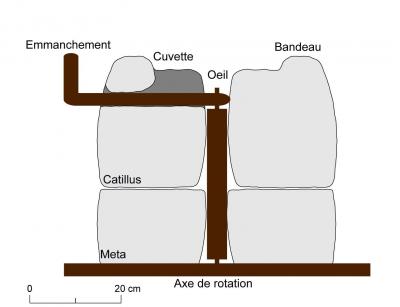 Chamant - Les artisans gaulois ont exploité, directement sous la surface du sol, des affleurements d’un calcaire dur dont ils ont extrait de larges blocs. Ils les ont façonnés en meules directement sur place. Des amoncellements circulaires de petits éclats de taille et de poussière blanche damée marquent leurs espaces de travail. Ces zones étaient protégées des intempéries par des abris construits. Une gestion organisée des déblais et des déchets de taille semble se dessiner au sein de la carrière. Le mobilier issu de la fouille est essentiellement composé d’ébauches et de ratés de taille de meules, abandonnés à différents stades de leur façonnage. À partir du second âge du Fer (des années -450 à -50), l’invention du moulin rotatif pour la transformation des céréales révolutionne un travail long et fastidieux. Ce nouveau moulin est composé de deux meules circulaires superposées, l’une fixe (la meta) sur laquelle tourne la seconde (le catillus). Le grain est ajouté par poignées dans un trou creusé au centre du catillus qui le guide entre les deux pierres. La meule tourne grâce à un manche de bois inséré dans son flanc. Les grains sont broyés, ressortant sous forme de gruau et de farine sur le pourtour. L’ensemble de la carrière de Chamant fait l’objet d’un relevé photogrammétrique par drone. Pour comprendre la chaîne opératoire qui va de l’extraction des blocs à leur façonnage en meules, les archéologues procèdent à la fouille mécanique de la carrière afin de récolter un échantillon représentatif des déchets de taille. Une fouille manuelle permet ensuite de préciser l’emplacement des ateliers et l’organisation des postes de travail. Cette approche vise à reconstituer les gestes et les outils des artisans. Éclats et ratés de taille collectés lors de la fouille sont lavés à haute pression, enregistrés et étudiés sur place. Pour constituer un fond documentaire pérenne, les archéologues utilisent également la technique de la photogrammétrie d’objets qui permet d’enregistrer les vestiges en 3D et d’observer plus finement les marques d’outils.
Chamant - Les artisans gaulois ont exploité, directement sous la surface du sol, des affleurements d’un calcaire dur dont ils ont extrait de larges blocs. Ils les ont façonnés en meules directement sur place. Des amoncellements circulaires de petits éclats de taille et de poussière blanche damée marquent leurs espaces de travail. Ces zones étaient protégées des intempéries par des abris construits. Une gestion organisée des déblais et des déchets de taille semble se dessiner au sein de la carrière. Le mobilier issu de la fouille est essentiellement composé d’ébauches et de ratés de taille de meules, abandonnés à différents stades de leur façonnage. À partir du second âge du Fer (des années -450 à -50), l’invention du moulin rotatif pour la transformation des céréales révolutionne un travail long et fastidieux. Ce nouveau moulin est composé de deux meules circulaires superposées, l’une fixe (la meta) sur laquelle tourne la seconde (le catillus). Le grain est ajouté par poignées dans un trou creusé au centre du catillus qui le guide entre les deux pierres. La meule tourne grâce à un manche de bois inséré dans son flanc. Les grains sont broyés, ressortant sous forme de gruau et de farine sur le pourtour. L’ensemble de la carrière de Chamant fait l’objet d’un relevé photogrammétrique par drone. Pour comprendre la chaîne opératoire qui va de l’extraction des blocs à leur façonnage en meules, les archéologues procèdent à la fouille mécanique de la carrière afin de récolter un échantillon représentatif des déchets de taille. Une fouille manuelle permet ensuite de préciser l’emplacement des ateliers et l’organisation des postes de travail. Cette approche vise à reconstituer les gestes et les outils des artisans. Éclats et ratés de taille collectés lors de la fouille sont lavés à haute pression, enregistrés et étudiés sur place. Pour constituer un fond documentaire pérenne, les archéologues utilisent également la technique de la photogrammétrie d’objets qui permet d’enregistrer les vestiges en 3D et d’observer plus finement les marques d’outils.
https://www.inrap.fr/extraction-et-fabrication-de-meules-gauloises-chamant-oise-17281#
